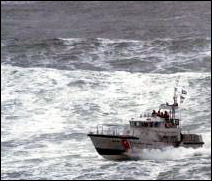- Reporting
- Training
- International Training
- Base Services
- Information
- PTC
- NATON Bulletin
- Contact TCYorktown
Security Levels

 NMLBS History
NMLBS History
The National Motor Lifeboat School (NMLBS) is located at the mouth of the Columbia River on the United States' northwestern coast at a point of land called “Cape Disappointment”. The river's strong current runs headlong into the strength of the Pacific Ocean tides at this river mouth and coupled with the frequent storms create some of the roughest waters in the world. Since 1878 this area, also known as the “Graveyard of the Pacific”, has long been home for Coast Guard rescue facilities and its predecessor the U.S. Lifesaving Service.
During the 1960's and early 70's local Coast Guard units pooled their resources in order to conduct coxswain and crew training on the then new 44-foot motor lifeboats. It was acknowledged that these steel-hulled boats were more capable than the wooden 36-foot lifeboats they were replacing. The crews manning them were typically very experienced with the leadership of seasoned veterans whose seamanship skills were passed on directly to each new crewmember. The localized training allowed small groups of Coast Guard crews to share experiences and techniques. A slow trend of decreasing experience base among Coast Guard crews could also be seen through this period.
The Coast Guard's Thirteenth District (Oregon and Washington coastal area) sought out a method of sharing the lessons learned through hard practical experience with these junior members. They established a training curriculum and routinely gathered their resources to put on classes focused at operating the 44-foot motor lifeboat in the surf environment. The success of these gatherings in passing on skills was soon recognized as potentially valuable for all motor lifeboat coxswains nationwide. The training concept was to use experienced Surfmen from the United States northwest coast to show other coxswains from around the nation how best to use the motor lifeboat in its designed element.
 Resources and budget were identified to give dedicated lifeboats to the newly born school along with personnel to provide maintenance and instruction. With the establishment of a formalized curriculum the U.S. Coast Guard's National Motor Lifeboat School was established in 1980 in Ilwaco, Washington co-located with the existing rescue station at Cape Disappointment. With surf conditions often causing 10 to 20 foot breaking waves and wind / sea state extremes such as Beaufort Force 10 across the wide river mouth (also known as a bar), the location was ideal for the lifeboat school. Increased training needs and a focus on standardization have caused the lifeboat school to expand through the years. This included new shore maintenance facilities, offices and classrooms that were dedicated in April 1993.
Resources and budget were identified to give dedicated lifeboats to the newly born school along with personnel to provide maintenance and instruction. With the establishment of a formalized curriculum the U.S. Coast Guard's National Motor Lifeboat School was established in 1980 in Ilwaco, Washington co-located with the existing rescue station at Cape Disappointment. With surf conditions often causing 10 to 20 foot breaking waves and wind / sea state extremes such as Beaufort Force 10 across the wide river mouth (also known as a bar), the location was ideal for the lifeboat school. Increased training needs and a focus on standardization have caused the lifeboat school to expand through the years. This included new shore maintenance facilities, offices and classrooms that were dedicated in April 1993.

